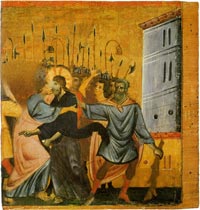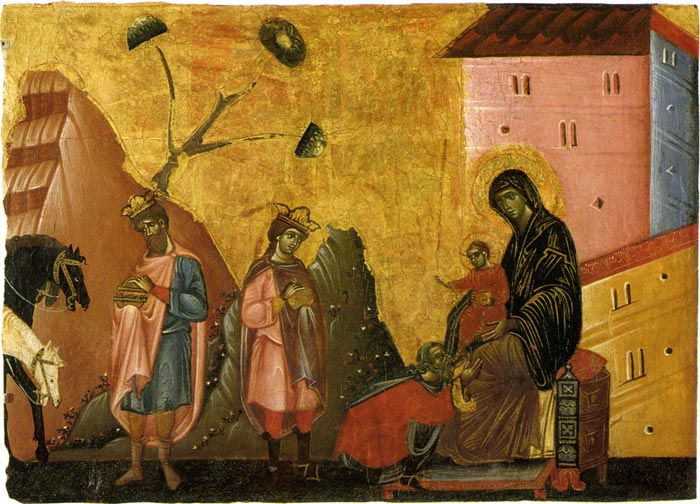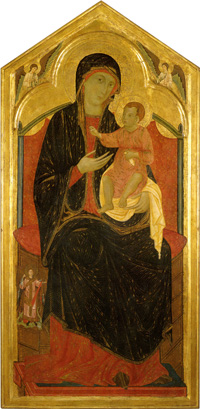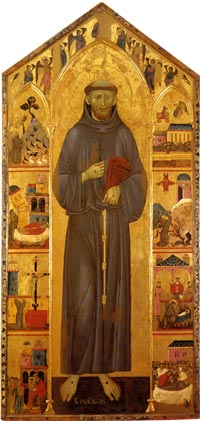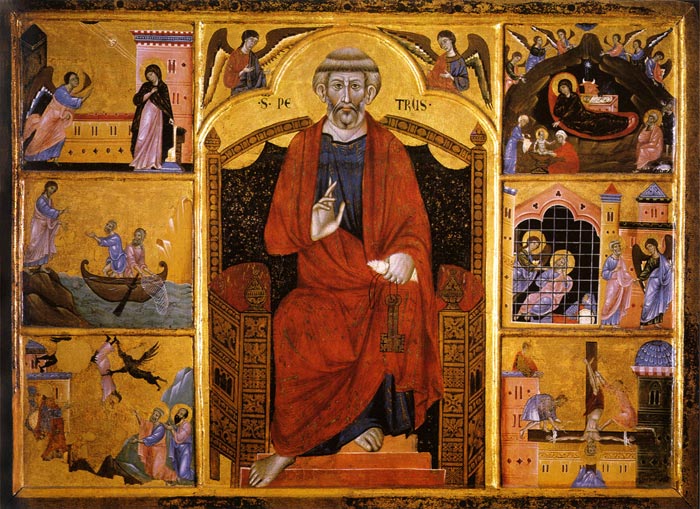 |
Guido di Graziano, Saint Peter Enthroned, about 1280, Siena, Pinacoteca Nazionale
|
Guido da Siena (Guido di Graziano) |
| Guido of Siena, also known as Guido di Graziano, was an Italian Byzantine style painter of the 13th century. He may have made significant advances in the techniques of painting, much as Cimabue much later accomplished. We know nothing of the life of this painter whose name appears in the inscription on a large altarpanel, the Majestas formerly in the basilica of St. Domenic in Siena and now in the Palazzo Pubblico. Under the throne of the Madonna and Child are the words: ME GUIDO DE SENIS — DIEBUS DEPINXIT AMENIS — QUEM CHRISTUS LENIS — NULLIS VELIT ANGERE PENIS — A.D.M.CC.XXI (I was painted in happy times by Guido da Siena whom merciful Christ afflicted with no suffering — 1221). Guido is primarily known for a painting which is now split into several pieces. The church of S. Domenico in Siena contains a large painting of the Virgin and Child Enthroned with six angels above. The Benedictine convent of the same city has a triangular pinnacle representing the Saviour in benediction, with two angels. This was once a portion of the same composition, which was originally a triptych. The principal section of this picture has a rhymed Latin inscription, giving the painter's name as Guido de Senis, with the date 1221. However, this may not be genuine, and the date may really read as 1281. There is nothing particular to distinguish this painting from other work of the same period except that the heads of the Virgin and Child are much superior – in natural character and graceful dignity – to anything painted before Cimabue. As a result, there is some dispute as to whether these heads are really the work of a man who painted in 1221, long before Cimabue. Crowe and Cavalcaselle have proposed that the heads were repainted in the 14th century, perhaps by Ugolino da Siena. If Crowe and Cavalcaselle are right, Cimabue maintains his claim to the advancement of the art. Beyond this, little is known of Guido da Siena. A picture in the Academy of Siena is attributed to him (a half-figure of the Virgin and Child, with two angels), which dates (probably) between 1250 and 1300. Also in the church of S. Bernardino in the same city is a Madonna dated 1262. Milanesi has proposed that this is by Guido Graziani, although there is no record of Graziani earlier than 1278, when he is mentioned as the painter of a banner. Guido da Siena appears always to have painted on panel, not in fresco on the wall. It is possible that he was a pupil of Pietrolino, and the master of Diotisalvi, Mino da Turrita and Berlinghieri da Lucca. He collaborated with Dietisalvi di Speme. |
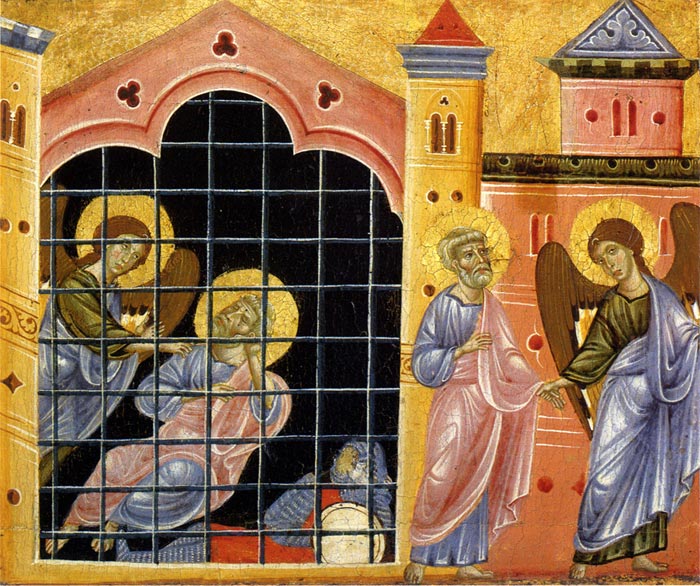 |
Guido di Graziano, Saint Francis (detail), after 1270, Siena, Pinacoteca Nazionale
|
[1] The first Sienese painter whose name is known to us is Guido da Siena, who was active in the second half of the thirteenth century. This does not mean that there were no native-born painters working in Siena before this time. Indeed, there is a large group of panel paintings by anonymous artists which attest to the fact that early in the thirteenth century, if not actually in the late twelfth cenutry, Siena already had a lively tradition of painting, but its style was not yet distinct from that of other centers in Tuscany and the Umbrian-Roman regions. The oldest extant paintings are three Crosses-in the church of San Pietro in Villore at San Giovanni d'Asso, in the Museum of Religious Art in Montalcino, and Cross No. 597 in the Gallery of Siena — and these indicate that it is the school of Spoleto in Umbria rather than Lucchese or Pisan painting which has influenced the Sienese style. This is seen particularly in the choice of delicate colors, the extensive use of blue, as well as in the motif of Christ alive on the cross (Christus triumphans). The celebrated Cross in the Cathedral of Spoleto is the source for the three Sienese examples and is signed and dated by Alberto Sotio in 1187. Among other panels of the same period is the Altarfrontal dated 1215 (the oldest Sienese painting which can be dated with certainty) from the Ardenga Abbey and now in the Siena Gallery, and the Madonna formerly in the Cathedral and now in the Museum of the Cathedral, Siena. These examples are proof of the fact that Sienese painting did not develop as an offshoot of the Tuscan tradition but rather was rooted in the Umbrian-Roman school. Nevertheless, this trend, which was absorbed without significant change, though with a certain form and refinement in the course of its evolution during the Italian Romanesque, was completely transformed by the new wave of Byzantine style which first nurtured the art of Pisa which had the closest contacts with Byzantium, and shortly after the middle of the thirteenth century reached Siena. In Pisa, this style is best seen in the art of Giunta Pisano. It is that style which Vasari and other historians called the "Greek manner," and its most typical, if not its most accomplished and outstanding, exponent is Guido da Siena. Enzo Carli , Sienese Painting, p.15, New York Graphic Society, Greenwich, 1956. Art in Tuscany | Sienese Biccherna Covers | Biccherne Senesi |
| This article uses material from the Wikipedia article Guido da Siena and other Wikipedia articles and is published under the GNU Free Documentation License. This article incorporates text from a publication now in the public domain: Chisholm, Hugh, ed (1911). Encyclopædia Britannica (Eleventh ed.). Cambridge University Press. |

